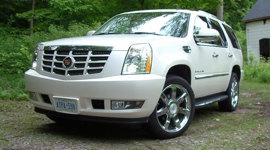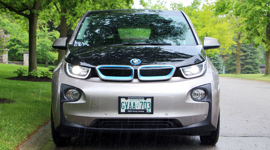Comparison Data
|
2014 BMW i3
|
2014 Chevrolet Volt
|
|---|---|
|
Engine Displacement
0.6L
|
1.4L
|
|
Engine Cylinders
I2
|
I4
|
|
Peak Horsepower
170 hp
|
149 hp
|
|
Peak Torque
184 lb-ft
|
273 lb-ft
|
|
Fuel Economy
5.7 / 6.3 / 6.0 L/100 km cty/hwy/cmb gas; 2.0 Le/100 km (17.9 kWh/100 km) electric; 116 km electric-only range
|
6.7 / 5.9 / 6.4 L/100 km cty/hwy/cmb gas; 2.4 Le/100 km (21.4 kWh/100 km) cmb electric; 61 km electric-only range
|
|
Cargo Space
261 L / 1,099 L seats down
|
300 L / n/a seats down
|
|
Base Price
$44,950
|
$36,895
|
|
A/C Tax
$100
|
$100
|
|
Destination Fee
$2,690
|
$1,600
|
|
Price as Tested
$59,590
|
$44,075
|
|
Optional Equipment
$11,850 – Range extender, $4,000; Suite Interior package, $4,600; Technology Package, $2,500; DC SAE Combo fast charging, $750
|
$5,480 – Crystal Red paint, $565; 17″ aluminum wheels, $695; MyLink infotainment w/nav, $995; Bose premium audio, $685; Premium Trim Package, $1,210; Safety Package 1, $705; Safety Package 2, $625
|
Review by Michael Bettencourt, photos by Michael Bettencourt and Jonathan Yarkony
Yes, the time has come for the reigning, undefeated Canadian plug-in sales champ, the Chevrolet Volt, to come under some serious, leather-lined fire. Sure, the all-new and futuristic BMW i3’s higher 45 grand starting price compared to its more mainstream $37k market rival will handicap the i3’s sales prospects somewhat, but there’s no question that BMW’s unique four-seat urban-friendly hatchback introduces a level of commitment to and innovation in plug-in vehicles unseen so far, with the possible exception of all-electric startup brand Tesla.
But new Teslas start at close to 80 large in Canada, before potential provincial clean car rebates of up to $8,500 on it and the i3 (and all other BEVs) in central Canada. And while a fully loaded i3 can venture up close to the 60 grand mark before taxes, compared to the Volt’s roughly $43k ceiling, the BMW i3 with a gas-engine range extender option is technologically the most similar to the Volt than any other plug-in vehicle currently on the Canadian market.
The Volt’s starting MSRP of $36,895, with similar provincial plug-in rebates available in Ontario ($8,231) and Quebec ($8,000), is still pricier than the all-electric Nissan Leaf that starts closer to $31k. However, the Leaf unfortunately doesn’t work as well for nearly as many buyers in Canada (yet), with range-sapping winter temperatures and much less developed fast charging infrastructure than in many parts of the U.S. So whereas the American-built Leaf and Volt trade the plug-in sales title like kids with stacks of sticker doubles, the Nissan so far in the lead there for 2014, no plug-in has been able to approach the Volt’s sales supremacy in Canada.
Could the BMW have enough widespread yet upscale appeal to mount a credible sales challenge to the Volt? The i3 has already won the 2014 World Green Car of the Year, an award the Volt won back in 2011, setting the stage for our quick but thorough drive and evaluation of them both for an afternoon.
Design/Body
Like or hate its unique design, the BMW i3 looks like a car from the future – and it is. As the first in BMW’s new ‘i' series of vehicles, this small hatchback is built using lightweight carbon-fibre reinforced plastic (CFRP) body panels, sitting on top of a flat battery pack, which BMW says makes it easy to switch body styles by switching out the top “Lifebody” module. These lightweight body panels are produced in a newly constructed facility in Moses Lake, Washington, using virtually emissions-free hydro-electric power, before being shipped to Leipzig for final assembly – where the i3 and upcoming i8 sports car will be the first cars built using only wind-generated electricity.
“The tagline ‘Born electric’ means we don’t have to shoehorn batteries and systems into current gas cars,” said Marc Belcourt, BMW Canada’s national manager for the ‘i' brand. “We have plenty of support (and investment) from the top.”
The strong CFRP body structure helped BMW to omit the centre B-pillar, while installing funky rear “coach” doors that open clamshell-style. Yes, it looks cool to see right through the car with all the doors open, just like the defunct Honda Element and dearly departed Mazda RX-8 (RIP). But the small rear doors of the i3 need the front doors to open first, so if you’re dropping off kids or more than one friend somewhere, either the driver or passenger will likely have to step out to allow enough room for rear seat riders to escape – a major annoyance when it’s pouring rain or bitterly cold. It’s also one that Volt owners or passengers won’t have to face with its conventional four doors.
Conventional also describes the styling of Chevy’s green halo car – the Volt’s a worthy step up from the bland-as-plain-rice-cakes Cruze upon which it’s obviously based, with a wink of the gorgeous Cadillac ELR there too in the Volt’s pointed nose and squat-hardened rear end. Many buyers (most?) will prefer the Volt’s more understated looks to the i3’s bolder, ready-for-Armageddon styling, so combined with the more practical four doors, this round goes to the Chevy, though with bonus points for BMW for innovation and kick-ass coolness.
Interior
Here is where the BMW eats up the Volt, and the Chevy’s Cruze roots come back to bite it. What looks perfectly fine in a 20 grand commuter car becomes tougher to justify at double that price, even with the Volt’s nicer leather. Granted, there’s a uniquely high-tech centre stack as well as a high definition digital LED screen in front of the driver that helps modernly distinguish the Volt’s interior ambiance. That stack is largely button-less, but not quite, thankfully, as one comes to appreciate having at least the tiny buttons under most controls when the touch sensitive ones above are not quite sensitive enough – or too much so.
In contrast, the i3’s interior once again boasts an all-new sci-fi-worthy form factor, but a much more universally appealing one. It takes advantage of not having a big, bulky engine in its nose to provide an airy, spacious front seat, with wood accents that flow generously throughout the empty space behind the driver’s instrumentation, laid out on an iPad-mini sized flat tablet, and towards the larger but still flat centre screen.
It’s not the cleanly integrated dashes we’re used to, with both flat panel screens appearing added on afterwards rather than wrapped into an overall unit. There’s no doubt that designers wanted to emphasize here that this is no ordinary car – and they’ve done so. Advantage BMW.
Drivetrain/Range
What makes both cars truly unique is their advanced drivetrains. The i3 starts life as a pure electric car, with a 22 kWh battery that BMW says can travel up to 160 km on battery power alone, or slightly more in the most extreme electron-sipping EcoPro+ mode. Early owner reports suggest that 130 km is closer to the real-world range for non-hyper-milers, which is exactly the electric-only i3’s EPA-rated range. BMW i3 BEV owners will never need to visit a gas station, filling up on juice while the car’s parked in the garage, most likely using a Level Two EVSE (costs usually between $500-$1,000, plus about the same for installation). This takes about four hours for a complete empty to 100 per cent charge, or about 15 hours on a regular 110 volt outlet when out and about.
If 130 km is not enough to reach cottage country, BMW offers three options that’ll help get you there. The first is an onboard gasoline-powered two-cylinder engine mounted below the rear cargo deck that never powers the wheels directly, but simply generates the juice to recharge the batteries. With this $4,000 option, total range rises to 240 km, says the EPA, thanks to its tiny seven litre gas tank.
Also available is a $750 DC fast charger, which technically can charge the i3 from empty to 80 percent full in 30 minutes, but because it’s the new SAE Combo fast charger standard and not the CHAdeMO now available on a limited basis in all three EV-friendly provinces (Ontario, Quebec and BC), this fast charger option is useless until BMW or someone else actually introduces such a public fast charger.
Finally, BMW will also offer i3 drivers – BEV and REx owners – the ability to borrow a regular internal combustion BMW (a 1 to 3 Series) for the occasional long trip, at least during the four-year warranty period. That IC BMW may also help long trips because of the i3’s tiny 200 litre cargo space behind the rear seats, compared to the Volt’s much roomier 300 litre cargo area, though that’s still considerably smaller than your average compact sedan.
The Volt is available only as an extended range plug-in hybrid, with a 16.5 kWh battery large enough to power it for 50 to 70 km of all-electric range for most of the year, and then a 35 litre tank provides another 500+ km of premium gas-powered, road trip-eating range. The gas engine comes on when needed at temperatures less than four degrees Celsius, but can easily go months only on electricity only in the more temperate seasons.
As with any battery-electric vehicle or plug-in hybrid, this electric range will drop quickest on the highway, going up hills, or with climate control use in both winter and summer, in that order of depletion. Because both cars are largely silent in electric operation, the engine coming on will be fairly noticeable, though we didn’t drive the REx model long enough to hear how its twin-cylinder engine sounded compared to the muted growl of the Volt’s 1.4L four.
Performance/Value
Driving the i3 back to back against the Volt, the i3 certainly seems more athletic of the two, but also considerably less comfortable. Piloting the i3 in the city feeling like driving a manual transmission car in second gear, a product of the i3’s strong brake regeneration programming that dramatically slows the car even with a lightening of pressure on the accelerator. In the Leaf and the Tesla Model S, there’s a way to switch how aggressively this regeneration slows the car, but unfortunately, not on the i3.
Some folks prefer this one-foot style of driving, with owners saying it becomes a smoother ride after your right foot becomes used to making minute changes. Must take longer than a half day, as even with careful modulation, there were still a few overly sudden throttle lift “braking” that had my passenger’s head bopping around like I was a nervous newbie manual driver. The regen lessens on the highway, and with the high level of regen, the brake lights actually come on in the city, even if you don’t touch the brakes.
Straight-line performance is certainly in the i3’s favour, with the BEV version taking 7.2 seconds in the 0-100 km/h dash, about half a second faster than the heavier i3 REx model, with both of them much fleeter than the Volt’s official 9.2 seconds.
Power-wise, the i3 rings in at 170 hp and 184 lb-ft of torque, while the Volt counters with 149 hp and a healthy 273 lb-ft of torque, the latter most apparent when the Volt is in its most energetic Sport mode. Still, the much lighter i3 weights between 1,300 and 1,420 kg, and feels much more energetic than the softer launching and braking Volt.
Despite the marketing behind the Chevrolet and BMW badges, the Volt is a relative sea of luxurious smoothness in both its ride and handling compared to the i3. The BMW’s taller body stays impressively flat in transitions, and cornering grip is surprisingly good considering its super-skinny 155 mm-wide tires, though the ride feels choppier than the Volt. The Volt is far from the ideal long-distance mile muncher, its seats and more cramped-feeling interior betraying it over long hauls, but with the Chevy’s lower price, smoother city comportment, larger gas tank and still responsive Sport mode, its overall usability and value help it nip ahead of the i3’s higher driving fun factor.
Conclusion
Though any BMW versus Chevrolet comparison test is rare, and may seem just plain wrong to some onlookers and both companies themselves, the reality is that the all-new BMW i3’s combination of futuristic looks, interior luxury and athletic driving persona offers a vastly different offering to the Volt. Tight i3 supply will likely limit its sales challenge to the Volt in its first year, but once it offers buyers a less imposing regen setting especially, it just may pose the strongest challenge to the Volt’s Canadian plug-in sales title yet.




























